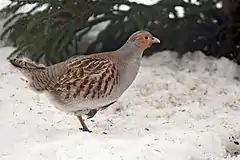| Perdix[1] | |||
| Brisson, 1760[2] | |||
 Przedstawiciel rodzaju – kuropatwa zwyczajna (P. perdix) | |||
| Systematyka | |||
| Domena | |||
|---|---|---|---|
| Królestwo | |||
| Typ | |||
| Podtyp | |||
| Gromada | |||
| Podgromada | |||
| Infragromada | |||
| Rząd | |||
| Rodzina | |||
| Podrodzina | |||
| Plemię | |||
| Rodzaj |
Perdix | ||
| Typ nomenklatoryczny | |||
|
Perdix cinerea Brisson, 1760 (= Tetrao perdix Linnaeus, 1758) | |||
| Synonimy | |||
|
| |||
| Gatunki | |||
| |||
Perdix – rodzaj ptaków z podrodziny bażantów (Phasianinae) w rodzinie kurowatych (Phasianidae).
Zasięg występowania
Morfologia
Długość ciała 28–31 cm, rozpiętość skrzydeł 45–48 cm; masa ciała 200–600 g (samce są nieco większe i cięższe od samic)[7].
Systematyka
Etymologia
- Perdix (Perdrix): łac. perdix, perdicis „kuropatwa”, od gr. περδιξ perdix, περδικος perdikos „kuropatwa”[8].
- Starna: włoska nazwa Starna dla kuropatwy zwyczajnej[9]. Gatunek typowy: Tetrao perdix Linnaeus, 1758.
- Sacfa: nazwa Sakpha ze wschodniego Tybetu dla kuropatwy tybetańskiej (por. Rhakpa z centralnego Tybetu)[10]. Gatunek typowy: Sacfa hodgsoniae Hodgson, 1856.
Podział systematyczny
Do rodzaju należą następujące gatunki[11]:
- Perdix perdix – kuropatwa zwyczajna
- Perdix dauurica – kuropatwa wschodnia
- Perdix hodgsoniae – kuropatwa tybetańska
Przypisy
- ↑ Perdix, [w:] Integrated Taxonomic Information System (ang.).
- ↑ M. J. Brisson: Ornithologie, ou, Méthode contenant la division des oiseaux en ordres, sections, genres, especes & leurs variétés : a laquelle on a joint une description exacte de chaque espece, avec les citations des auteurs qui en ont traité, les noms quils leur ont donnés, ceux que leur ont donnés les différentes nations, & les noms vulgaires. T. 1. Parisii: Ad Ripam Augustinorum, apud Cl. Joannem-Baptistam Bauche, bibliopolam, ad Insigne S. Genovesae, & S. Joannis in Deserto, 1760, s. 26, 219. (fr. • łac.).
- ↑ M.T. Brünnich: Zoologiae fundamenta praelectionibus academicis accommodata. Lipsiae: Apud Frider. Christ. Pelt, 1772, s. 86. (łac.).
- ↑ Ch.L. Bonaparte: A geographical and comparative list of the birds of Europe and North Americ. London: J. Van Voorst, 1838, s. 43. (ang.).
- ↑ B.H. Hodgson. On a new Perdicine bird from Tibet. „The Journal of the Asiatic Society of Bengal”. 25, s. 165, 1856. (ang.).
- ↑ F. Gill, D. Donsker & P. Rasmussen (red.): IOC World Bird List (v11.2). [dostęp 2022-01-04]. (ang.).
- ↑ P.J.K. McGowan: Family Phasianidae (Pheasants and Partridges). W: J. del Hoyo, A. Elliott & J. Sargatal: Handbook of the Birds of the World. Cz. 2: New World Vultures to Guineafowl. Barcelona: Lynx Edicions, 1994, s. 504–505. ISBN 84-87334-15-6. (ang.).
- ↑ Perdix, [w:] The Key to Scientific Names, J.A. Jobling (red.), [w:] Birds of the World, S.M. Billerman et al. (red.), Cornell Lab of Ornithology, Ithaca [dostęp 2022-01-04] (ang.).
- ↑ Starna, [w:] The Key to Scientific Names, J.A. Jobling (red.), [w:] Birds of the World, S.M. Billerman et al. (red.), Cornell Lab of Ornithology, Ithaca [dostęp 2022-01-04] (ang.).
- ↑ Sacfa, [w:] The Key to Scientific Names, J.A. Jobling (red.), [w:] Birds of the World, S.M. Billerman et al. (red.), Cornell Lab of Ornithology, Ithaca [dostęp 2022-01-04] (ang.).
- ↑ Systematyka i nazwy polskie za: P. Mielczarek & M. Kuziemko: Plemię: Phasianini Horsfield, 1821 (wersja: 2021-12-05). [w:] Kompletna lista ptaków świata [on-line]. Instytut Nauk o Środowisku Uniwersytetu Jagiellońskiego. [dostęp 2022-01-04].
This article is issued from Wikipedia. The text is licensed under Creative Commons - Attribution - Sharealike. Additional terms may apply for the media files.